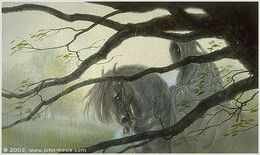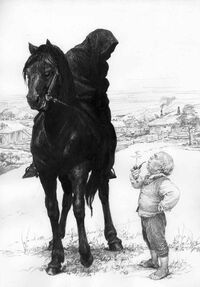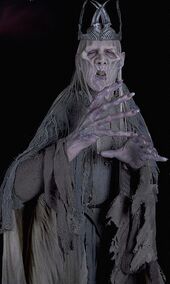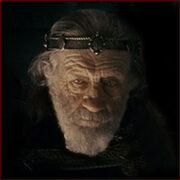Tag: Visual edit |
HiddenVale (talk | contribs) No edit summary Tag: Visual edit |
||
| Line 1: | Line 1: | ||
{{Infobox Person Servants of Evil |
{{Infobox Person Servants of Evil |
||
|image = Khamul_the_black_easterling.jpg |
|image = Khamul_the_black_easterling.jpg |
||
| − | |caption = |
+ | |caption = |
|name = Khamûl |
|name = Khamûl |
||
|othernames = Shadow of the East, The Black Easterling, Khamûl the Easterling |
|othernames = Shadow of the East, The Black Easterling, Khamûl the Easterling |
||
| Line 8: | Line 8: | ||
|death = [[TA 3019]] |
|death = [[TA 3019]] |
||
|realms = [[Rhûn]], [[Dol Guldur]] (under overlordship of [[Sauron]]) |
|realms = [[Rhûn]], [[Dol Guldur]] (under overlordship of [[Sauron]]) |
||
| − | |weapon = [[Sword]], [[Morgul-blade |
+ | |weapon = [[Sword]], [[Morgul-blade]] |
|race = [[Men]] (originally) |
|race = [[Men]] (originally) |
||
|gender = Male |
|gender = Male |
||
| − | |hair = |
+ | |hair = |
|culture = [[Nazgûl]] (Ringwraiths), formerly [[Easterlings]] |
|culture = [[Nazgûl]] (Ringwraiths), formerly [[Easterlings]] |
||
|voice = [[Andy Serkis]], Daran Norris (game) |
|voice = [[Andy Serkis]], Daran Norris (game) |
||
Revision as of 16:46, 18 March 2020
- "Shire... Baggins..."
- —Khamûl, to Farmer Maggot[1]
Khamûl was one of the nine Ringwraiths second to the Witch-king, in Middle-earth after Arnor was defeated. During the Third Age, he held Dol Guldur as Sauron's lieutenant. After the Witch-king was slain, he became the Lord of Nazgûl for a short period.[2]
Biography
Second Age

Khamûl the Easterling, by John Howe
Khamûl was once a mortal man who ruled the lands of the East known as Rhûn. He received one of the nine Rings of Power from the Dark Lord Sauron and in time he was corrupted and became one of his servants.
He first appeared as one of the Nazgûl in SA 2251.[3]
Third Age

Khamûl in the Shire, by Denis Gordeev
In TA 2951, Sauron sent three Nazgûl to abide in Dol Guldur, and Khamûl commanded the fortress thereafter.[4][5][3]
War of the Ring
Khamûl was the Wraith who pursued the Hobbits to Bucklebury ferry in the Shire, and who asked Farmer Maggot for "Baggins" just before Frodo Baggins left Hobbiton.[1]
Khamûl also appeared in the Battle of the Pelennor Fields with the other Nazgûl, mounted on his Fellbeast and killing Gondor's soldiers at the beginning of the battle. After the Witch-king´s demise, he and the other seven lesser Nazgûl retreated to Mordor.[6]
Afterwards, Khamûl became the leader of the Nazgûl. He led them to the Battle of the Black Gate riding his Fellbeast, before they were attacked by the Eagles. The Nazgûl retreated when they sensed that Frodo claimed the Ring for himself, and were lured towards Mount Doom. He fell by the eruption's fire.[7]
Names
Khamûl was called the Shadow of the East, the Second Chief, and the Black Easterling.[5] He was the only Ringwraith whose name was given by J.R.R. Tolkien, as well as one of the six Ringwraiths not of Númenorean descent.
Portrayal in adaptations
Peter Jackson's film trilogy

The model for Khamûl's true appearance

Khamûl before he was corrupted, according to TheLandOfShadow.com
In Peter Jackson's film adaptation of The Lord of the Rings trilogy, Khamûl was shown briefly when speaking to Farmer Maggot, who directs him onward to Hobbiton. Later, the Hobbits evade Farmer Maggot, but Frodo senses a presence and tells his friends to get off the road. Hiding behind a tree, the Hobbits hushed as Khamûl approached, catching their scent. As the four stayed quiet, Merry throws a sack of vegetables behind the Rider's horse, alarming Khamûl and causing him to leave the Hobbits undetected.
In The Return of the King, after the ring was destroyed, Khamûl died along with the seven other Ringwraiths in the eruption of Mount Doom, the Witch-king having perished earlier during the Battle of the Pelennor Fields.
The Hobbit film trilogy
Concept art of Khamûl, as seen in The Hobbit films
In the The Hobbit films, the nine Ringwraiths had been buried in the High Fells of Rhudaur, but emerged at the summons of the Necromancer, who is revealed to be Sauron. In the The Hobbit: The Battle of the Five Armies, Khamûl and the other eight Ringwraiths engaged the White Council in battle, with Khamûl wearing spectral "Khaganate" Easterling armor.
Video games
- Though not named in the game, Khamûl was featured in The Lord of the Rings Online as the Lieutenant of Dol Guldur. He commands the forces of Sauron in Mirkwood and was the final boss of the 12-person raid on Barad Guldur, along with his fellbeast.
He was once known as The Cursed Rider, as one of the Nine Nazgûl, he was the recipient of Orôm (Warmonger), one of the nine Rings of Power that were forged for Men. He was an Easterling King, but his name is lost in time, and he is now known by the most common of his many nicknames.
- In Electronic Arts' The Battle for Middle-earth II: The Rise of the Witch-king, Khamûl is one of two named Ringwraith heroes of the Mordor faction who ride on fellbeasts.
Pen & Paper RPGs
In the Middle-Earth Role Playing Game, he is Khamul the Easterling. Khamul the Easterling was born Komul I in S.A. 1744 at Laeg Goak in eastern Endor. He was the eldest son of Hionvor Mul Tanul of the Womaw. He was raised by the Lord' s Elven consort, Dardarian, who also served as his principal advisor until his ascent to the throne in S.A. 1844. Dardarian's influence upon the king of Womawas Drus corrupted his outlook upon the world, and gave him a longing for the gift of immortality. Though he possessed Elven ancestry, it merely extended life for those of his lineage rather than continuing it indefinitely.
He found his own rule losing popularity among his own people in favor of Numenorean ambassadors. Since the Dunedain had established trade relations with the Womaw in S.A. 900, the influence from the Men of Westernesse increased over the years and grew to sway the populations of Womawas Drus' southern holdings. They built several fortified colonies, and diplomatically forced several concessions upon the part of Komul I's kingdom. By S .A. 1 994, the internal stability of the Hionvor's rule was crumbling with many of the Womaw lords renouncing their loyalty to the King. Komul became a desperate man. With his entire kingdom collapsing about him, he turned to the only ally he knew: Dardarian. He met with his stepmother at the Isle of Sunrises, where she seduced him with beauty, charm, and an enticing offer of immortality. Komiil was proud, desperate, and had a deep longing for immortality; he accepted her offer, and an alliance was formed between Dardarian's A var kingdom of Helkanen and the Womawas Drus. This alliance gave Komul the power to demand concessions from the Numenoreans the following year, quashing any thoughts of Dunadan conquest. The pact with Dardarian had many benefits, for it secured the Womaw kingdom from collapse. Unfortunately, it would spell the downfall for their Hionvor.
Dardarian served Sauron of Mordor and was charged with the duty of corrupting Komul. In S.A. 1 996, she delivered the item which would bestow the Womaw king with immortality. He accepted one of the Nine Rings of Power and fell under the sway of the Lord of the Rings. His reign over the Eastern Kingdom came to an abrupt end. Komul disappeared early in the spring of S.A. 1997, after remaining virtually isolated from any other person. The Hionvor's apparent lack of interest sparked a bloody succession struggle for Komul's throne. Assassinations, spying, and intrigue marred the once peaceful court of the Womaw. Seeing that holding his power in the kingdom would be to no avail, he abdicated his throne to a Numenorean supported faction with his cousin Aon at the head. No one realized the true reasons for Komul's abdication, but it probably saved the kingdom from Sauron's iron grip. Komul could do nothing save swear an oath of vengeance upon his former court.
Komul's whereabouts from S.A. 1997-2000 remain unknown, but he appeared at the gates of the Dark Tower in S.A. 2000. His name became Khamul, as this was how it was pronounced in the Black Tongue. He was given the stewardship of Barad-dur, which he held until he was pushed out by Ar-Pharazon, he traveled to the east and corrupted several tribes there.
He alter returned to Mordor abiding in Nurn, during the War of the Ring, but did not take part until the fall of Dark Tower in 3441, when he and his Master came forth to fight the Elven host. He slew many, but disappeared into Shadow after Isildur cut off Sauron's ring. He remained in Shadow until he joined his master in Dol Goldur in 1050. Following that he spent some time further in the southeast fought the pressures of the corrupted Blue Wizards for control of the region, but it never panned out. In the 1600s he returned to Sauron in Dol Goldur, where he remained until the fall of the Watch of Mordor. He was sent along with seven lesser Nazghul to take back Mordor to prepare for their Master's return.
In 2063, he returned to his homeland to finish his millenia-old vow, and conquered it for the Shadow. Then he returned to Mordor at the same time as his Master. He spent time traveling between Mordor and Dol Guldur. During one of these journies he captured Thrain II, imprisoned him in Dol Goldur, took the dwarf's ring of power and tortured him. He never got information he wanted, and Thrain escaped to give Gandalf the key to Erebor. Sauron punished him for his failure but he still remained one of Sauron's four most powerful servants. Khamul fled with Sauron during White Council's attack 2941 and traveled to Mordor.
Khamul would later return to Dol Gondor and lead the forces there on the attacks of the people of the North.
He would later fall when he was called back to stop Frodo at Mount Doom, but perished when the ring was destroyed.
Khamûl is of the Avaradan (Half-Elves) kings, descended from Abar Elves, and the Womaw (same line as the Edain of Numenor).
Titles and Nicknames
- Komûl I (his birth name and title)
- Mûl Komûl
- Hionvor of the Womaw (Lord, King)
- Hionvor of Wom Shryac
- The Dragon-lord (title given to him by his people for the Dragonskin armor he wore)
- Khamûl (his name in Black Speech)
- Second of the Nine (The Second)
- The Black Easterling
- The Easterling
- Khamûl the Easterling
- Master of the Hold
- The Black Ranger (Ranger)
- Shadow of the East
- Fell Rider
Earlier versions of the legendarium
In prior versions of the stories, Khamûl was stationed at Dol Guldur on March 6th, when Aragorn revealed himself to Sauron and began marching on the Wood-elf realms on March 10th. On March 11th, his forces began assailing the nearby Lórien. After this failed, much of his force passed around the border of the woods and entered the Wold of Rohan. On March 12th, they were met with Ents sent east from Fangorn and Isengard, and were routed. Lórien was then attacked twice more on March 15th and March 22nd, but was never entered. The forces of Dol Guldur also went north into Mirkwood, battling the forces of King Thranduil under Mirkwood's trees, the climax of these battles being on March 15, 3019 which after a "long battle... and great ruin and fire" was won by Thranduil's forces.
Trivia
- Khamûl is the only Nazgûl whose true name is revealed.
Translations
| Foreign Language | Translated name |
| Arabic | خمول |
| Armenian | Խամոլ |
| Belarusian Cyrillic | Кhамул |
| Bengali | খামুল |
| Bulgarian Cyrillic | Хамул |
| Cambodian | ខមឡ ? |
| Chinese (Hong Kong) | 克哈穆爾 |
| Georgian | კჰამული |
| Greek | Χαμούλ |
| Gujarati | ખમુલ |
| Hebrew | כאמול |
| Hindi | खमुल |
| Japanese | ハムール |
| Kazakh | Кһамұл (Cyrillic) Khamul (Latin) |
| Kannada | ಖಮುಲ |
| Kyrgyz Cyrillic | Кhамул |
| Macedonian Cyrillic | Кхамул |
| Marathi | खमुल |
| Mongolian Cyrillic | Кhамул |
| Nepalese | खमुल |
| Pashto | خمول |
| Persian | خامول |
| Punjabi | ਖਮੁਲ |
| Russian | Кхамул |
| Sanskrit | खमुल् |
| Serbian | Камул (Cyrillic) Kamul (Latin) |
| Sinhalese | ඛමුල් |
| Tajik Cyrillic | Кҳамул |
| Tamil | க்ஹமுல் |
| Telugu | ఖముల |
| Thai | คามูล |
| Ukrainian Cyrillic | Кгамул |
| Urdu | خمول |
| Uzbek | Кҳамул (Cyrillic) Khamul (Latin) |
| Yiddish | כאַמול |
References
- ↑ 1.0 1.1 The Lord of the Rings, The Fellowship of the Ring, Book One, Chapter IV: "A Short Cut to Mushrooms"
- ↑ Unfinished Tales, Part Three: The Third Age, IV: "The Nazgûl Hunt for the Ring"
- ↑ 3.0 3.1 The Lord of the Rings, Appendix B: The Tale of Years (Chronology of the Westlands), "The Great Years"
- ↑ Unfinished Tales, Introduction, Part Three, IV: "The Hunt for the Ring"
- ↑ 5.0 5.1 Unfinished Tales, Part Three: The Third Age, chapter IV: "The Hunt for the Ring", Notes
- ↑ The Lord of the Rings, The Return of the King, Book Five, Chapter VI: "The Battle of the Pelennor Fields"
- ↑ The Lord of the Rings, The Return of the King, Book Six, Chapter III: "Mount Doom"
